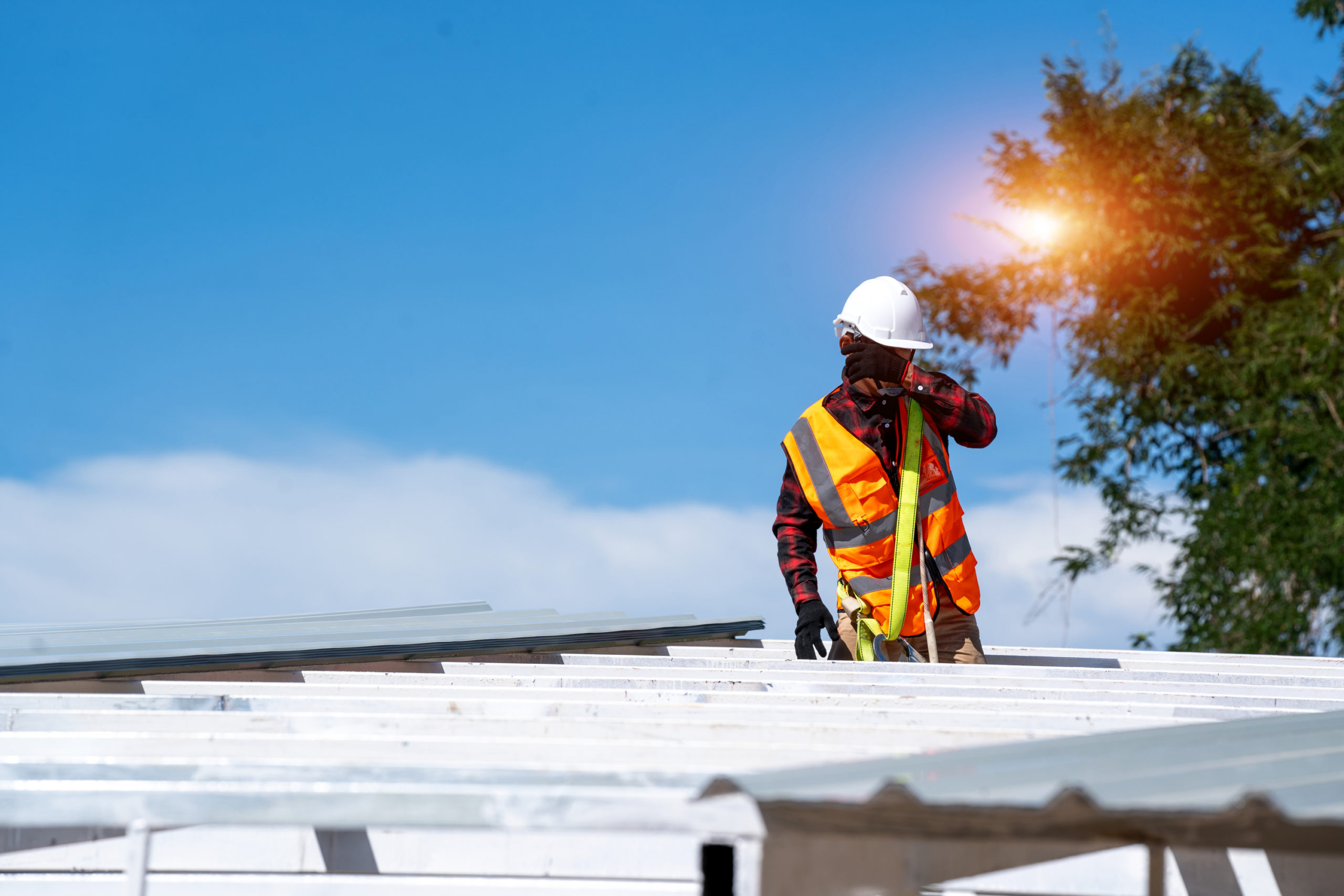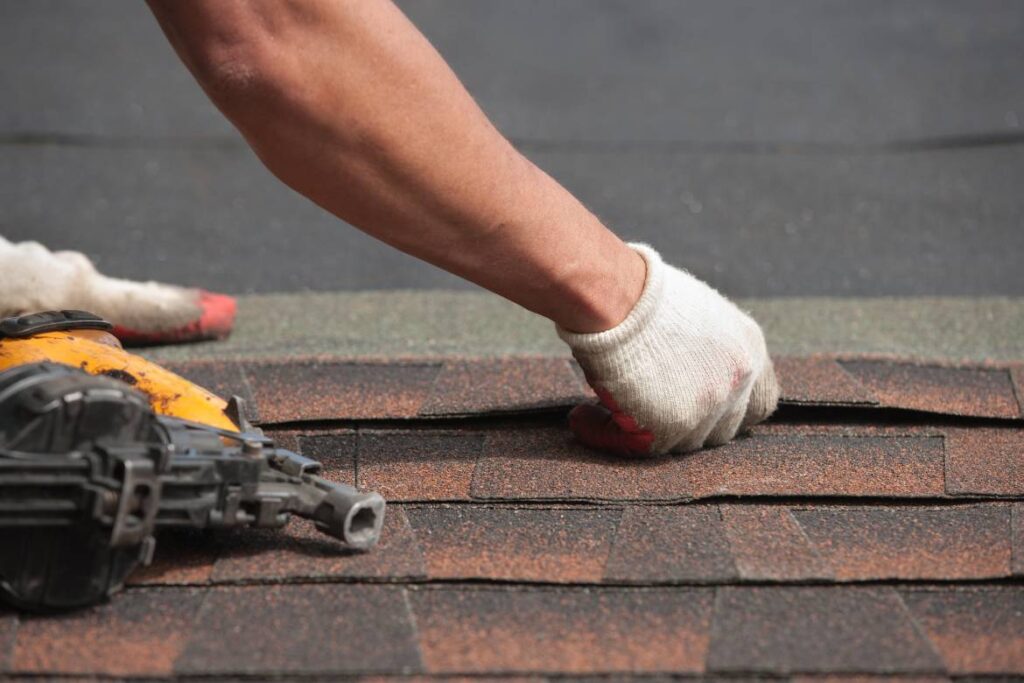The roof above your head keeps you safe and dry, but repairs and maintenance require venturing up onto that roof—a task that can be perilous if proper safety precautions are not taken. While hiring a professional roofer for all jobs may seem like the safest option, doing some repairs yourself can save you money.
However, roofing work should never be taken lightly, as even minor slips or falls from rooftop heights can have serious, life-changing consequences. In this post, we’ll share some essential roofing safety tips for anyone tackling DIY projects on their home’s roof. Following these practices can help keep you safe while still allowing you to save money through do-it-yourself repairs.

How to Approach Roofing Projects Safely
Roofing projects are not for the faint-hearted or for those without a head for heights. There’s certainly more to it than just scaling a ladder. To ensure you’re prepared for the task ahead, understanding the safety practices is paramount.
Dress Appropriately
The right attire can make a significant difference in your safety. Wear a hard hat to protect your head from any falling debris. Don rubber-soled shoes or boots, which provide the best traction against slipping. Also, consider wearing a tool belt to keep your hands free while you’re working.
Use Safety Equipment
Invest in a good quality roof harness system, especially when working on steep roofs. This is a critical tool that can save you from a potentially fatal fall. Use a stable, extendable ladder that is firmly positioned. Always ensure the ladder extends at least 3 feet above the roof edge.
Stay Aware of the Weather
Always check the weather forecast before embarking on any roofing work. Never attempt to work on the roof during rain, snow, or strong winds, as the roof can become slippery, posing a significant risk to your safety.
Maintain a Clean Workspace
Keep your workspace as tidy as possible to prevent tripping over tools, cords, and other potential hazards. A clean work area also makes it easier to spot and avoid loose roofing materials or exposed nails.
Never Work Alone
Always have a buddy system when working on a roof. Having someone on the ground can help in case of emergencies and is handy for passing tools or other materials.
Plan Your Work
Before you start any roofing work, it’s essential to have a clear plan laid out. Identify the tools and materials you’ll need, and have a step-by-step process in mind. A well-thought-out plan can help minimize the time spent on the roof and reduce the risk of accidents from rushed or unplanned actions.
Take Regular Breaks
Roofing work can be physically demanding, and fatigue can set in quickly. Take regular breaks to rest and hydrate. Remember, tiredness can lead to careless mistakes, which can be dangerous when you’re working at height.
Be Extra Cautious Near Roof Edges
Steer clear of the roof edges and be aware of your location on the roof at all times. One misstep could result in a fall. If you have to work near the edge, use a safety rope and harness to provide an extra layer of security.
Educate Yourself on Emergency Procedures
Accidents can still occur despite our best efforts. It’s crucial to know what to do in an emergency, such as how to use a first-aid kit or who to call for help. Having this knowledge could save a life in the event of an accident.

Respect the Limitations of Your Skills
While DIY roofing can save money, it’s important to know when a job is beyond your capabilities. If a project seems too complex or dangerous, don’t hesitate to call a professional. It’s better to spend a little more than to risk serious injury. Visit their website to learn more about roofing safety practices to keep in mind for your next DIY project.
Additional Tips for Year-Round Roof Maintenance
While you may have been meticulous about your safety while tackling DIY roofing projects, maintaining your roof year-round is just as important. Regular preventive maintenance can help you detect problems early on, extend the lifespan of your roof, and ensure it remains strong and sturdy, whatever the weather.
Regularly Inspect Your Roof
Carry out inspections twice a year and after major storms. Check for cracked or missing shingles, signs of water damage, or moss and algae growth. Early detection of potential issues can save you costly repairs down the line.
Keep Gutters Clean
Ensure your gutters are clear of leaves, twigs, and other debris. Blocked gutters can cause water to spill over onto your roof or walls, leading to water damage over time.
Trim Overhanging Branches
Trim any branches that hang over your roof. Not only can falling branches cause considerable damage, but overhanging branches can also provide easy access for animals to get onto your roof.
Check Attic Ventilation
Poor ventilation in the attic can cause heat and moisture to build up and damage your roof. Ensure your attic has adequate ventilation to prevent any such issues.
Schedule Professional Inspections
Even with regular DIY checks, scheduling a professional roof inspection at least once a year can help find issues you may have overlooked.
Beware of Power Lines
While working on the roof, be aware of power lines. Contacting them can cause serious injuries or even be fatal. Always maintain a safe distance from electrical lines, and do not attempt to move them on your own. If power lines near your workspace are a concern, contact a professional or your utility company.
Use the Right Tools
Using the right tools for specific tasks can make your work easier and safer. For instance, a roofing shovel will be more effective and safer to use for removing old shingles than a regular shovel. Always use tools as they are intended to prevent mishaps.
Check for Nesting Animals
Before you start working, check for any signs of birds, bats, or other animals that may have made a home on your roof. Not only can they pose a risk to you, but some species are protected by law and may not be disturbed. If you discover any animals, contact local animal control or a wildlife removal service.
Replace Damaged Shingles Immediately
If you notice a damaged or missing shingle, replace it as soon as possible. Even a single damaged shingle can lead to leaks, which can cause significant damage to your home.
Final Thoughts
No matter how well you plan and prepare, accidents can still happen. Be sure to have a first-aid kit and emergency contact numbers on hand in case of any incidents. Remember, safety should always be your top priority when working on the roof. By following these tips and continuously educating yourself on proper roofing safety practices, you can tackle DIY roofing projects with confidence and stay safe while doing so.






